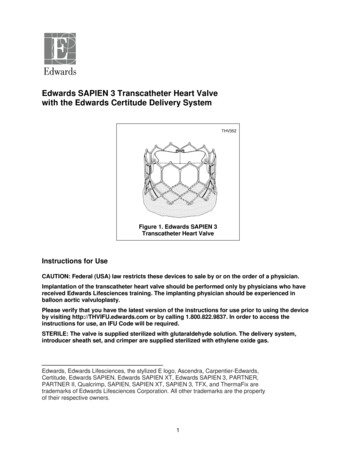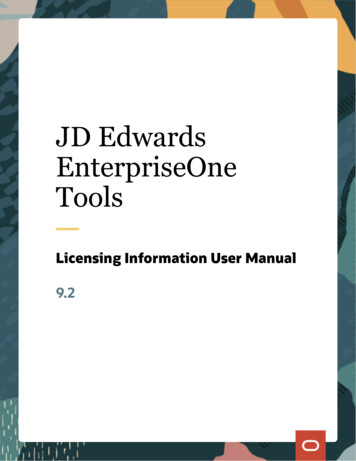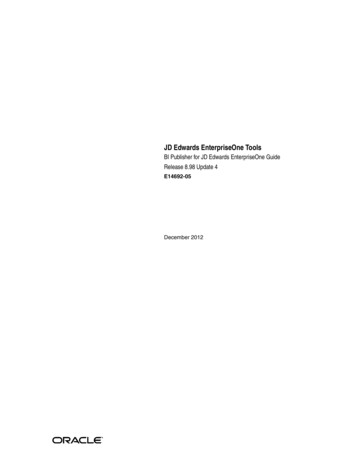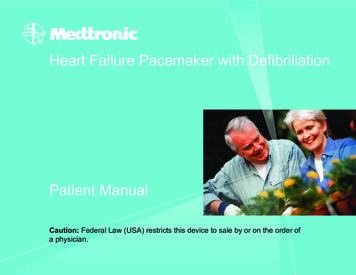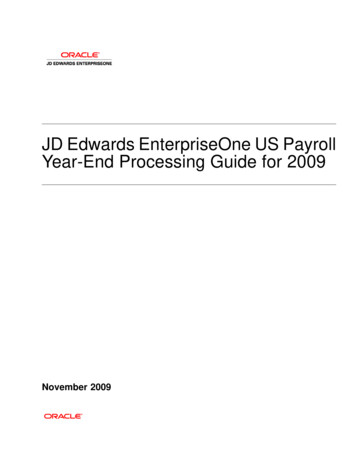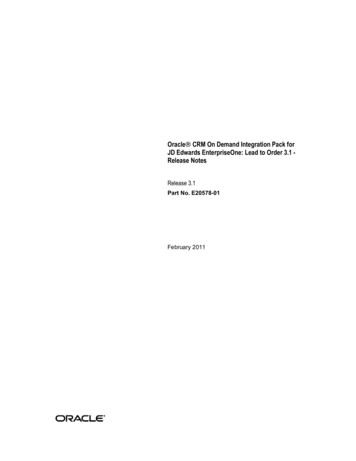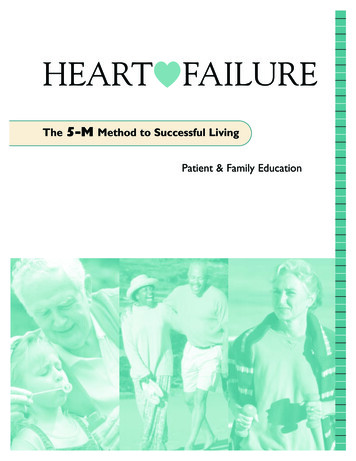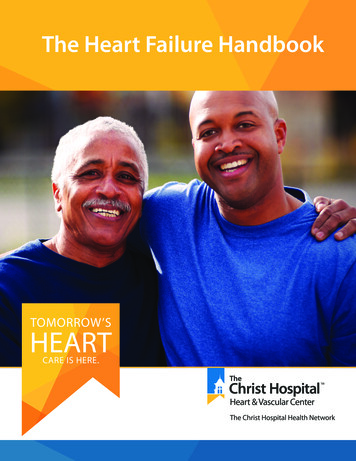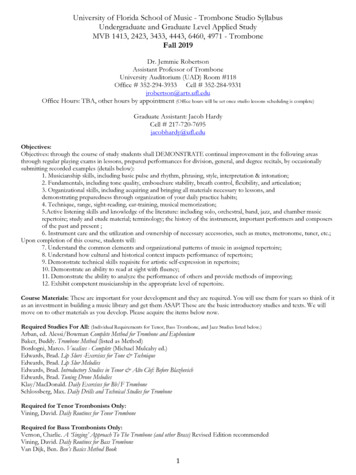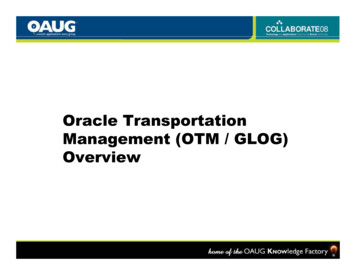
Transcription
CoEdwards SAPIEN 3Transcatheter Heart Valve with the Edwards Commander DeliverySystemInstructions for UseCAUTION: Federal (USA) law restricts these devices to sale by or on the order of a physician.Implantation of the transcatheter heart valve should be performed only by physicians who havereceived Edwards Lifesciences training. The implanting physician should be experienced inballoon aortic valvuloplasty.Please verify that you have the latest version of the instructions for use prior to using the deviceby visiting http://THVIFU.edwards.com or by calling 1.800.822.9837. In order to access theinstructions for use, an IFU Code will be required.STERILE: The THV is supplied sterilized with glutaraldehyde solution. The delivery system,eSheath introducer set, and crimper are supplied sterilized with ethylene oxide gas.Edwards, Edwards Lifesciences, the stylized E logo, Carpentier-Edwards, Edwards Commander,Edwards eSheath, Edwards SAPIEN, Edwards SAPIEN 3, eSheath, Qualcrimp, PARTNER, PARTNER II,SAPIEN, SAPIEN 3, TFX and ThermaFix are trademarks of Edwards Lifesciences Corporation.All other trademarks are the property of their respective owners.1
1.0 Device Description Edwards SAPIEN 3 Transcatheter Heart Valve- Model 9600TFX (Figure 1)The Edwards SAPIEN 3 Transcatheter Heart Valve (THV) is comprised of a balloon-expandable,radiopaque, cobalt-chromium frame, trileaflet bovine pericardial tissue valve, and polyethyleneterephthalate (PET) fabric skirt. The leaflets are treated according to the Carpentier-Edwards ThermaFixprocess.Table 1Valve SizeHeight20 mm15.5 mm23 mm18 mm26 mm20 mm29 mm22.5 mmTable 2Native Valve Annulus Size(CT)Native Valve Annulus Size(TEE)THV SizeArea DerivedDiameterArea16-19 mm273 – 345 mm218.6-21 mm20 mm18-22 mm338 – 430 mm220.7-23.4 mm23 mm430 – 546 mm223.4-26.4 mm26 mm21-25 mm224-28 mm540 – 683 mm26.2-29.5 mm29 mmTHV size recommendations are based on native valve annulus size, as measured by transesophagealechocardiography (TEE) or computed tomography (CT). Patient anatomical factors and multiple imagingmodalities should be considered during THV size selection. Note: Risks associated with undersizing andoversizing should be considered. Edwards Commander Delivery System (Figure 2)The Edwards Commander delivery system (usable length 105 cm) is used for delivery of the EdwardsSAPIEN 3 transcatheter heart valve and consists of a Flex Catheter to aid in valve alignment to theballoon, tracking, and positioning of the THV. The delivery system includes a tapered tip to facilitatecrossing of the native valve. The handle contains a Flex Wheel to control flexing of the Flex Catheter, anda Balloon Lock and Fine Adjustment Wheel to facilitate valve alignment and positioning of the valve withinthe native annulus. A stylet is included within the guidewire lumen of the delivery system. The BalloonCatheter has radiopaque Valve Alignment Markers defining the working length of the balloon. Aradiopaque Center Marker in the balloon is provided to help with valve positioning. A radiopaque TripleMarker proximal to the balloon indicates the Flex Catheter position during deployment. The inflationparameters for THV deployment are:Table Rated BurstPressure(RBP)9600LDS2020 mm11 mL7 atm9600LDS2323 mm17 mL7 atm9600LDS2626 mm23 mL7 atm9600LDS2929 mm33 mL7 atm2
Figure 2 Edwards Commander Delivery System Qualcrimp Crimping Accessory (Figure 3)The Qualcrimp crimping accessory (packaged with the Edwards Commander delivery system) is usedduring crimping of the THV.Figure 3Laminated Qualcrimp Edwards eSheath Introducer SetRefer to the Edwards eSheath Introducer Set for device description. Edwards CrimperRefer to the Edwards Crimper instructions for use for device description.2.0IndicationsThe Edwards SAPIEN 3 Transcatheter Heart Valve (THV), model 9600TFX, and accessories areindicated for relief of aortic stenosis in patients with symptomatic heart disease due to severe nativecalcific aortic stenosis who are judged by a heart team, including a cardiac surgeon, to be at high orgreater risk for open surgical therapy (i.e., Society of Thoracic Surgeons operative risk score 8% or at a 15% risk of mortality at 30 days).3
3.0ContraindicationsThe THV and delivery systems are contraindicated in patients who cannot tolerate ananticoagulation/antiplatelet regimen or who have active bacterial endocarditis or other active infections.4.0 Warnings Observation of the pacing lead throughout the procedure is essential to avoid the potential risk ofpacing lead perforation. There is an increased risk of stroke in transcatheter aortic valve replacement procedures, ascompared to balloon aortic valvuloplasty or other standard treatments. The devices are designed, intended, and distributed for single use only. Do not resterilize or reusethe devices. There are no data to support the sterility, nonpyrogenicity, and functionality of thedevices after reprocessing. Incorrect sizing of the THV may lead to paravalvular leak, migration, embolization and/or annularrupture. Accelerated deterioration of the THV may occur in patients with an altered calcium metabolism. Prior to delivery, the THV must remain hydrated at all times and cannot be exposed to solutions otherthan its shipping storage solution and sterile physiologic rinsing solution. THV leaflets mishandled ordamaged during any part of the procedure will require replacement of the THV. Caution should be exercised in implanting a THV in patients with clinically significant coronary arterydisease. Patients with pre-existing mitral valve devices should be carefully assessed prior to implantation ofthe THV to ensure proper THV positioning and deployment. Do not use the THV if the tamper evident seal is broken, the storage solution does not completelycover the THV, the temperature indicator has been activated, the THV is damaged, or the expirationdate has elapsed. Do not mishandle the delivery system or use it if the packaging or any components are not sterile,have been opened or are damaged (e.g. kinked or stretched), or the expiration date has elapsed. Use of excessive contrast media may lead to renal failure. Measure the patient’s creatinine level priorto the procedure. Contrast media usage should be monitored. Patient injury could occur if the delivery system is not un-flexed prior to removal. Care should be exercised in patients with hypersensitivities to cobalt, nickel, chromium, molybdenum,titanium, manganese, silicon, and/or polymeric materials. The procedure should be conducted under fluoroscopic guidance. Some fluoroscopically guidedprocedures are associated with a risk of radiation injury to the skin. These injuries may be painful,disfiguring, and long-lasting. THV recipients should be maintained on anticoagulant/antiplatelet therapy, except whencontraindicated, as determined by their physician. This device has not been tested for use withoutanticoagulation. Do not add or apply antibiotics to the storage solution, rinse solutions, or to the THV.5.0 Precautions Long-term durability has not been established for the THV. Regular medical follow-up is advised toevaluate THV performance. Glutaraldehyde may cause irritation of the skin, eyes, nose and throat. Avoid prolonged or repeatedexposure to, or breathing of, the solution. Use only with adequate ventilation. If skin contact occurs,immediately flush the affected area with water; in the event of contact with eyes, seek immediatemedical attention. For more information about glutaraldehyde exposure, refer to the Material SafetyData Sheet available from Edwards Lifesciences.4
To maintain proper valve leaflet coaptation, do not overinflate the deployment balloon. Appropriate antibiotic prophylaxis is recommended post-procedure in patients at risk for prostheticvalve infection and endocarditis. Safety, effectiveness, and durability have not been established for valve-in-valve procedures. Safety and effectiveness have not been established for patients with the ied aortic annulusoSevere ventricular dysfunction with ejection fraction 20%oCongenital unicuspid or congenital bicuspid aortic valveoMixed aortic valve disease (aortic stenosis and aortic regurgitation with predominant aorticregurgitation 3 )oPre-existing prosthetic heart valve or prosthetic ring in any positionoSevere mitral annular calcification (MAC), severe ( 3 ) mitral insufficiency, or GorlinsyndromeoBlood dyscrasias defined as: leukopenia (WBC 3000 cells/mL), acute anemia (Hb 9g/dL), thrombocytopenia (platelet count 50,000 cells/mL), or history of bleedingdiathesis or coagulopathyoHypertrophic cardiomyopathy with or without obstruction (HOCM)oEchocardiographic evidence of intracardiac mass, thrombus, or vegetationoA known hypersensitivity or contraindication to aspirin, heparin, ticlopidine (Ticlid ), orclopidogrel (Plavix ), or sensitivity to contrast media, which cannot be adequately premedicatedoSignificant aortic disease, including abdominal aortic or thoracic aneurysm defined as maximalluminal diameter 5 cm or greater; marked tortuosity (hyperacute bend), aortic arch atheroma(especially if thick [ 5 mm], protruding, or ulcerated) or narrowing (especially with calcificationand surface irregularities) of the abdominal or thoracic aorta, severe “unfolding” and tortuosity ofthe thoracic aortaoAccess characteristics that would preclude safe placement of 14F or 16F Edwards eSheathIntroducer Set, such as severe obstructive calcification, severe tortuosity or diameter less than5.5 mm or 6 mm, respectivelyoBulky calcified aortic valve leaflets in close proximity to coronary ostia6.0 Potential Adverse EventsPotential risks associated with the overall procedure including potential access complications associatedwith standard cardiac catheterization, balloon valvuloplasty, the potential risks of conscious sedationand/or general anesthesia, and the use of angiography: Death Stroke/transient ischemic attack, clusters or neurological deficit Paralysis Permanent disability Respiratory insufficiency or respiratory failure Hemorrhage requiring transfusion or intervention Cardiovascular injury including perforation or dissection of vessels, ventricle, myocardium or valvularstructures that may require intervention Pericardial effusion or cardiac tamponade5
Embolization including air, calcific valve material or thrombus Infection including septicemia and endocarditis Heart failure Myocardial infarction Renal insufficiency or renal failure Conduction system defect which may require a permanent pacemaker Arrhythmia Retroperitoneal bleed AV fistula or pseudoaneurysm Reoperation Ischemia or nerve injury Restenosis Pulmonary edema Pleural effusion Bleeding Anemia Abnormal lab values (including electrolyte imbalance) Hypertension or hypotension Allergic reaction to anesthesia, contrast media, or device materials Hematoma Syncope Pain or changes at the access site Exercise intolerance or weakness Inflammation Angina Heart murmur FeverAdditional potential risks associated with the use of the THV, delivery system, and/or accessories include: Cardiac arrest Cardiogenic shock Emergency cardiac surgery Cardiac failure or low cardiac output Coronary flow obstruction/transvalvular flow disturbance Device thrombosis requiring intervention Valve thrombosis Device embolization Device migration or malposition requiring intervention Valve deployment in unintended location6
Valve stenosis Structural valve deterioration (wear, fracture, calcification, leaflet tear/tearing from the stent posts,leaflet retraction, suture line disruption of components of a prosthetic valve, thickening, stenosis) Device degeneration Paravalvular or transvalvular leak Valve regurgitation Hemolysis Device explants Nonstructural dysfunction Mechanical failure of delivery system, and/or accessories Non-emergent reoperation7.0 Directions for Use7.1 Required EquipmentTable 4Product Name20 mm System(9600CM20A)23 mm System(9600CM23A)26 mm System(9600CM26A)29 mm System(9600CM29A)ModelEdwards SAPIEN 3Transcatheter Heart ValveEdwards Commander DeliverySystem*9600TFX (20 mm)9600TFX (23 mm)9600TFX (26 mm)9600TFX (29 mm)9600LDS209600LDS239600LDS269600LDS29Edwards eSheath IntroducerSet**914ES914ES914ES916ESEdwards Balloon Catheter9350BC169350BC209350BC239350BC25Inflation devices provided by Edwards LifesciencesEdwards Crimper9600CR* Includes the Qualcrimp Crimping Accessory,2-piece Crimp Stopper and loader** Or other compatible sheath provided by Edwards LifesciencesAdditional Equipment: 20 cc syringe or larger (x2) 50 cc syringe or larger High-pressure 3-way stopcock (x2) Standard cardiac catheterization lab equipment Fluoroscopy (fixed, mobile or semi-mobile fluoroscopy systems appropriate for use in percutaneouscoronary interventions) Transesophageal or transthoracic echocardiography capabilities Exchange length 0.035 inch (0.89 mm) extra-stiff guidewire Temporary pacemaker (PM) and pacing lead Sterile rinsing basins, physiological saline, heparinized saline, 15% diluted radiopaque contrastmedium Sterile table for THV and device preparation7.2 THV Handling and PreparationFollow sterile technique during device preparation and implantation.7
7.2.1 THV Rinsing ProcedureBefore opening the valve jar, carefully examine for evidence of damage (e.g. a cracked jar or lid, leakage,or broken or missing seals).CAUTION: THVs from containers found to be damaged, leaking, without adequate sterilant, ormissing intact seals must not be used for implantation.StepProcedure1Set up two (2) sterile bowls with at least 500 mL of sterile physiological saline to thoroughly rinse theglutaraldehyde sterilant from the THV.2Carefully remove the THV/holder assembly from the jar without touching the tissue. Verify the THVserial identification number with the number on the jar lid and record in the patient informationdocuments. Inspect the THV for any signs of damage to the frame or tissue.Rinse the THV as follows: Place the THV in the first bowl of sterile, physiological saline. Be sure thesaline solution completely covers the THV and holder. With the THV and holder submerged, slowlyagitate (to gently swirl the THV and holder) back and forth for a minimum of 1 minute. Transfer theTHV and holder to the second rinsing bowl of physiological saline and gently agitate for at least onemore minute. Ensure the rinse solution in the first bowl is not used. The THV should be left in thefinal rinse solution until needed to prevent the tissue from drying.3CAUTION: Do not allow the THV to come into contact with the bottom or sides of the rinse bowlduring agitation or swirling in the rinse solution. Direct contact between the identification tag andTHV is also to be avoided during the rinse procedure. No other objects should be placed in therinse bowls. The THV should be kept hydrated to prevent the tissue from drying.7.2.2 Prepare the ComponentsRefer to the Edwards eSheath Introducer Set, Edwards Crimper and Edwards Balloon Catheterinstructions for use for device preparation.StepProcedureVisually inspect all components for damage. Ensure the Edwards Commander delivery system is fullyunflexed and the balloon catheter is fully advanced in the flex catheter.1WARNING: To prevent possible damage to the balloon shaft, ensure that the proximal end of theballoon shaft is not subjected to bending.2Flush the flex catheter.3Carefully remove the distal balloon cover from the delivery system.4Remove the stylet from the distal end of the guidewire lumen and set aside. Flush the guidewirelumen with heparinized saline and insert the stylet back into the distal end of the guidewire lumen.Note: Failure to insert the stylet back into the guidewire lumen may result in damage to the lumenduring crimping process.5Place the delivery system into the default position and make sure that the flex catheter tip is coveredby the proximal balloon cover. Unscrew the loader cap from the loader tube and flush the loader cap.Place the loader cap over the proximal balloon cover and onto the flex catheter with the inside of thecap oriented towards the distal tip.6Fully advance the balloon catheter in the flex catheter.Peel off the proximal balloon cover over the blue section of the balloon shaft.7Attach a 3-way stopcock to the balloon inflation port. Partially fill a 50 cc or larger syringe with15-20 mL diluted contrast medium and attach to the 3-way stopcock.8Fill the inflation device provided by Edwards Lifesciences with excess volume relative to the indicatedinflation volume. Lock the inflation device and attach to the 3-way stopcock.9Close the 3-way stopcock to the Inflation device provided by Edwards Lifesciences and de-air thesystem using the 50 cc or larger syringe. Slowly release the plunger and leave zero-pressure in thesystem.8
StepProcedureClose the stopcock to the delivery system. By rotating the knob of the inflation device provided byEdwards Lifesciences, transfer the contrast medium into the syringe to achieve the appropriatevolume required to deploy the THV, per the following:1011Delivery SystemTHV SizeInflation VolumeModel 9600LDS2020 mm11 mLModel 9600LDS2323 mm17 mLModel 9600LDS2626 mm23 mLModel 9600LDS2929 mm33 mLClose the stopcock to the 50 cc or larger syringe. Remove the syringe. Verify that the inflation volumeis correct and lock the Inflation device provided by Edwards Lifesciences.CAUTION: Maintain the Inflation device provided by Edwards Lifesciences in the lockedposition until THV deployment.7.2.3 Mount and Crimp the THV on the Delivery SystemStepProcedure1Set up two (2) additional sterile bowls with at least 100 mL of sterile physiological saline to thoroughlyrinse the Qualcrimp crimping accessory.2Completely submerge the Qualcrimp crimping accessory in the first bowl and gently compress it toensure complete saline absorption. Slowly swirl the Qualcrimp crimping accessory for a minimum of1 minute. Repeat this process in the second bowl.3Remove the THV from the holder and remove the ID tag.4Attach the 2-piece crimp stopper to the base of the crimper and click into place.5With the crimper in the open position, gently place the THV into the crimper aperture. Gradually crimpthe THV until it fits into the Qualcrimp crimping accessory.6Place the Qualcrimp crimping accessory over the THV making sure the THV is parallel to the edge ofthe Qualcrimp.7Place the THV and Qualcrimp crimping accessory in crimper aperture. Insert the delivery systemcoaxially within the THV on the Valve Crimp Section (2-3 mm distal to the balloon shaft) with theinflow (fabric cuff end) of the THV towards the distal end of the delivery system.8Crimp the THV until it reaches the Qualcrimp Stop located on the 2-piece Crimp Stopper.9Gently remove the Qualcrimp crimping accessory from the THV. Remove the Qualcrimp Stop fromthe Final Stop, leaving the Final Stop in place.10Fully crimp the THV until it reaches the Final Stop.NOTE: Ensure that the Valve Crimp Section remains coaxial within the THV.11Repeat the full crimp of the THV two more times for a total of three full crimps.12Pull the balloon shaft and lock in the default position.13Flush the loader with heparinized saline. Immediately advance the THV into the loader until thetapered tip of the delivery system is exposed.CAUTION: To prevent possible leaflet damage, the THV should not remain fully crimped and/orin the loader for over 15 minutes.Attach the loader cap to the loader, re-flush the delivery system through the flush port and close thestopcock to the delivery system.14Remove the stylet and flush the guidewire lumen of the delivery system.CAUTION: Keep the THV hydrated until ready for implantation.CAUTION: The physician must verify correct orientation of the THV prior to its implantation;its inflow (fabric cuff end) should be oriented distally towards the tapered tip.9
7.3 Valvuloplasty and THV DeliveryValvuloplasty and THV delivery should be performed under conscious sedation and/or general anesthesiawith hemodynamic monitoring in a catheterization lab/hybrid operating room with fluoroscopic andechocardiographic imaging capabilities.Administer heparin to maintain the ACT at 250 sec during the procedure.CAUTION: Use of excessive contrast media may lead to renal failure. Measure the patient’screatinine level prior to the procedure. Contrast media usage should be monitored.CAUTION: Procedure may require an arterial cut-down with surgical closure of the puncture sitedue to the size of the arteriotomy.7.3.1 Baseline ParametersStepProcedure1Perform a supra-aortic angiogram with fluoroscopic view perpendicular to the aortic valve.2Evaluate the distance of the left and right coronary ostia from the aortic annulus in relation to the THVframe height.3Introduce a pacemaker (PM) lead until its distal end is positioned in the right ventricle.4Set the stimulation parameters to obtain 1:1 capture, and test pacing.7.3.2 ValvuloplastyRefer to Edwards Balloon Catheter Instructions for Use (IFU) for information on devicepreparation and handling.Note: Rapid ventricular pacing should be performed when using the Edwards Balloon Catheter forvalvuloplasty prior to aortic transcatheter valve implantation.After placement of the balloon at the intended site, begin rapid ventricular pacing. Once the systolic bloodpressure has decreased to 50 mmHg or below, balloon inflation can commence.CAUTION: THV implantation should not be carried out if the balloon cannot be fully inflated duringvalvuloplasty.7.3.3 THV DeliveryStepProcedure1Prepare and insert the Edwards eSheath Introducer Set. Refer to the Edwards eSheath Introducer Set IFUfor information on device preparation and handling.2Insert the loader into the sheath until the loader stops.Advance the Edwards Commander delivery system, with the Edwards logo facing up, through the sheathuntil the THV exits the sheath. Retract the loader to the proximal end of the delivery system.3NOTE: Maintain the proper orientation of the flex catheter (with the Edwards logo facing up)throughout the procedure.CAUTION: If accessing femorally or via the iliac, the THV should not be advanced through the sheathif the sheath tip is not past the aortic bifurcation.CAUTION: To prevent possible leaflet damage, the THV should not remain in the sheath for over5 minutes.10
StepProcedureIn a straight section of the aorta, initiate valve alignment by disengaging the Balloon Lock and pulling theballoon catheter straight back until part of the Warning Marker is visible. Do not pull past the WarningMarker.WARNING: To prevent possible damage to the balloon shaft, ensure that the proximal end of theballoon shaft is not subjected to bending.4Engage the Balloon Lock.Use the Fine Adjustment Wheel to position the THV between the valve alignment markers.CAUTION: Do not turn the Fine Adjustment Wheel if the Balloon Lock is not engaged.WARNING: Do not position the THV past the distal Valve Alignment Marker. This will prevent propervalve deployment.CAUTION: Maintain guidewire position in the left ventricle during valve alignment.Advance the catheter and use the flex wheel, if needed, and cross the aortic valve.5NOTE: Verify the Edwards logo is facing up. The delivery system articulates in a direction oppositefrom the flush port.6If additional working length is needed, remove the loader by unscrewing the loader cap and peeling theloader tubing from the delivery system.7Disengage the Balloon Lock and retract the tip of the Flex Catheter to the center of the Triple Marker.Engage the Balloon Lock.8Verify the correct position of the THV with respect to the aortic annulus.9As necessary, utilize the Flex Wheel to adjust the co-axiality of the THV and the Fine Adjustment Wheel toadjust the position of the THV.10Before deployment, ensure that the THV is correctly positioned between the Valve Alignment Markers andthe Flex Catheter tip is over the Triple Marker.Begin THV deployment: Unlock the Inflation device provided by Edwards Lifesciences.11 Begin rapid pacing; once systolic blood pressure has decreased to 50 mmHg or below, balloon inflationcan commence. Deploy the THV by inflating the balloon with the entire volume in the Inflation device provided byEdwards Lifesciences, hold for 3 seconds and confirm that the barrel of the inflation device is empty toensure complete inflation of the balloon. Deflate the balloon. When the balloon catheter has been completely deflated, turn off the pacemaker.7.3.4 System RemovalStep1ProcedureUnflex the delivery system while retracting the device, if needed. Verify that the Flex Catheter tip islocked over the Triple Marker and remove the delivery system from the sheath.CAUTION: Patient injury could occur if the delivery system is not unflexed prior to removal.2Remove all devices when the ACT level is appropriate. Refer to the Edwards Expandable IntroducerSheath Set instructions for use for device removal.3Close the access site.8.0 How SuppliedSTERILE: The THV is supplied sterilized with glutaraldehyde solution. The delivery system is suppliedsterilized with ethylene oxide gas.8.1 StorageThe THV must be stored at 10 C to 25 C (50 F to 77 F). Each jar is shipped in an enclosure containinga temperature indicator to detect exposure of the THV to extreme temperature.The delivery system should be stored in a cool, dry place.11
9.0 MR SafetyMR ConditionalThe Edwards SAPIEN 3 transcatheter heart valve has been determined to be MR Conditional. A patientwith this device can be safely scanned in an MR system meeting the following conditions: Static magnetic field of 1.5 tesla or 3 tesla. Maximum spatial gradient field of 2500 gauss/cm (25 T/m) or less. Maximum MR system reported, whole body averaged specific absorption rate (SAR) of 2 W/kg(Normal Operating Mode)Under the scan conditions defined above, the SAPIEN 3 transcatheter heart valve is expected to producea maximum temperature rise of 3.0 ºC after 15 minutes of continuous scanning.In non-clinical testing, the image artifact caused by the device extends as far as 10 mm from the implantfor spin echo images and 30 mm for gradient echo images when scanned in a 3.0T MRI system.The implant has not been evaluated in MR systems other than 1.5 or 3.0T.10.0Patient InformationPatient education brochures are provided to each site and should be given to the patient to inform them ofthe risks and benefits of the procedure and alternatives in adequate time before the procedure to be readand discussed with their physician. A copy of this brochure may also be obtained from EdwardsLifesciences by calling 1.800.822.9837. A patient implant card request form is provided with eachtranscatheter heart valve. After implantation, all requested information should be completed on this form.The serial number may be found on the package and on the identification tag attached to the transcatheterheart valve. The original form should be returned to the Edwards Lifesciences address indicated on the formand upon receipt, Edwards Lifesciences will provide an identification card to the patient.11.0 Recovered THV and Device DisposalThe explanted THV should be placed into a suitable histological fixative such as 10% formalin or 2%glutaraldehyde and returned to the company. Refrigeration is not necessary under these circumstances.Contact Edwards Lifesciences to request an Explant Kit.Used delivery system may be disposed of in the same manner that hospital waste and biohazardousmaterials are handled. There are no special risks related to the disposal of these devices.12.0 Clinical StudiesSUMMARY OF PRIMARY CLINICAL STUDYPrimary Clinical Study DesignThe PIIS3HR Cohort of the PARTNER II trial was a single arm, non-randomized, historical-controlledstudy to compare the third generation Edwards SAPIEN 3 THV system with the first generation EdwardsSAPIEN THV system in patients who either have high risk for surgery or cannot undergo surgery(inoperable). The valve sizes used in the PIIS3HR trial included only the 23, 26 and 29 mm sizes. The 20mm valve size was introduced into the trial after enrollment was completed with the three larger sizes,thus a separate nested registry, NR7, with identical inclusion/exclusion criteria as the PIIS3HR Cohortexcept for the aortic annulus diameter, was created to collect data for the 20 mm valve. Data from thePIIS3HR cohort and NR7 are pooled for the statistical analyses. For convenience, this combined cohort isreferred to as “PIIS3HR” hereafter.The database included 583 eligible patients enrolled at 29 investigational sites in the U.S.The study used an independent Data Safety Monitoring Board (DSMB) that was instructed to notifyEdwards Lifesciences of any safety or compliance issues, a Clinical Events Committee (CEC) that wasresponsible for adjudicating endpoint related events reported during the trial per a priori established12
[1]VARC 2 definitions, an ECG core laboratory for independent analysis of rhythm, and anechocardiographic core laboratory for independently analyzing all echocardiograms.AccountabilityAll 583 eligible patients were successfully implanted with a SAPIEN 3 THV, which constitutes the ValveImplant (VI) population. Among the VI population, 491 patients were implanted via the transfemoral (TF)access route, and 92 patients via the transapical (TA) or transaortic (TAo) access route.Table 5: Patient AccountabilityOverallTFTA /TAoEligible Patient58349192Population (EPP)Valve Implant58349192(VI) PopulationEligible Patient Population (EPP) consists of all enrolled patients who receivedtreatment assignment from the database and entered into the catheterizationlaboratory/hybrid suite and who remained eligible to receive the implant.Valve Implant (VI) Population consists of all enrolled patients who received aSAPIEN 3 implant, and retained the valve upon leaving the catheterization
50 cc syringe or larger High-pressure 3-way stopcock (x2) Standard cardiac catheterization lab equipment Fluoroscopy (fixed, mobile or semi-mobile fluoroscopy systems appropriate for use in percutaneous coronary interventions) Transesophageal or transthoracic echocardiography capabilities
